Every year, 60,000 children under five end up in emergency rooms after accidentally swallowing medications. Dogs and cats are just as vulnerable-pets ingest pills left on counters, in purses, or even tucked between couch cushions. It’s not rare. It’s not an accident waiting to happen. It’s happening right now in homes that think they’re doing enough.
Most parents assume child-resistant caps are enough. They’re not. Most pet owners think keeping meds in the bathroom cabinet is fine. It’s not. Humidity ruins pills. And pets? They’ll sniff out a gummy vitamin faster than you can say "oops."
Where You’re Probably Storing Medications (And Why It’s Dangerous)
The bathroom is the most common spot. It’s convenient. You brush your teeth there. You take your pills there. But bathrooms are humid. Heat and moisture break down medications-especially antibiotics, insulin, and thyroid pills. That’s not just ineffective. It’s risky. If a child finds a degraded pill, they might chew it anyway, not knowing it’s no longer safe.
And what about the kitchen counter? You pop a pill while making coffee. You leave the bottle there for a minute. A minute turns into an hour. A curious toddler climbs up. A dog jumps onto the counter. One slip. One sniff. One bite. That’s all it takes.
Even your purse or coat pocket isn’t safe. Studies show 65% of childhood medication incidents involve over-the-counter pills left in bags or jackets. Kids aren’t looking for trouble. They’re exploring. And if it looks like candy-gummies, chewables, colorful tablets-they’ll take it.
For pets, the danger is even sneakier. Human heart medications can kill a dog. Pet arthritis pills can poison a person. And flavored medications? They’re basically dog candy. A vet in Perth told me about a Labrador that ate an entire bottle of fish oil capsules meant for a cat-because they tasted like bacon. That’s not an exaggeration. It happened.
The Two-Minute Rule: Stop Leaving Pills Out
Here’s the truth: 52% of childhood poisonings happen because someone left a pill out while giving it. You open the bottle. You give the dose. You set the bottle down to grab water. You answer the door. You turn your back for 90 seconds. That’s all it takes.
The solution? The two-minute rule. After every single dose-whether it’s for your child, your partner, or your dog-put the medication away. Immediately. No exceptions. Not even for a second.
Make it a habit. Say it out loud: "Put it away." Train your kids to do it too. If they’re old enough to take their own meds, teach them to lock it back up. Make it part of the routine, like washing hands.
And if you’re giving a pet their medicine? Do it on a flat surface. Not the couch. Not the bed. Not the floor where they can dart in and snatch it. A kitchen table. A clean counter. Always. That way, if a pill drops, you see it. You pick it up. You don’t risk your dog finding it later.
Locked, High, and Separate: The Three-Layer Safety System
There’s no single magic solution. You need layers.
- Layer 1: Locked. Child-resistant caps are a start, not a finish. Use a lockable box. A combination lock bag. A biometric safe. Even a simple cabinet with a child lock works. The VADIC Safe Storage Bag (11" x 6") is one of the most popular and affordable options-under $20, and it holds a month’s supply.
- Layer 2: High. Store meds at least 5 feet above the ground. That’s above the reach of most toddlers, even if they climb. Don’t rely on "out of sight." Kids learn fast. Clear cabinets? They’ll see the pills. Use opaque containers or put them behind closed doors.
- Layer 3: Separate. Never mix human and pet meds. Ever. Store them in different rooms if you can. Keep dog meds in the kitchen pantry. Cat meds in the bedroom closet. Human meds in a locked box on a high shelf. Why? Because a cat’s kidney can’t handle a dog’s NSAID. And a child might grab a pet pill thinking it’s a vitamin.
One family in Fremantle did this: They bought a small lockbox, put all human meds inside, and mounted it on the wall above the kitchen cabinet. Pet meds went in a separate locked container in the laundry room. Within a week, their 2-year-old stopped trying to open the cabinet. Their golden retriever stopped sniffing around the vet bag. It wasn’t expensive. It wasn’t complicated. It just worked.

Gummy Vitamins and Flavored Pills: The Hidden Trap
Gummy vitamins are the #1 culprit in accidental ingestions. They look like candy. They taste like candy. And they’re everywhere-on nightstands, in backpacks, in the fridge. The CDC says 30% of childhood supplement poisonings come from gummies-even though they make up only 15% of the market.
Same goes for pet meds. Fish oil gummies for dogs? Chicken-flavored pills for cats? They’re designed to be tasty. That’s the problem.
Here’s what to do:
- Store gummy vitamins in the same locked box as your prescription pills. No exceptions.
- Never leave them on the counter-even "just for today."
- Use opaque containers. If you can’t see it, it’s less tempting.
- Teach kids: "These aren’t candy. They’re medicine."
And for pet owners: If your dog or cat has flavored meds, treat them like a loaded gun. Lock them up. Keep them separate. Never leave the bottle open.
What to Do With Old or Expired Medications
Don’t flush them. Don’t throw them in the trash loose. Don’t dump them down the sink.
The safest way? Mix them with something unappetizing-used coffee grounds, cat litter, or even dirt. Use a 1:1 ratio. Pour the mixture into a sealed plastic bag. Then toss it in the outdoor bin.
Why? Because someone (or something) could dig through your trash. A dog could find a whole bottle of painkillers. A kid could find a few pills in a compost pile. This method makes them unappealing and unusable. The EPA says this method is 92% effective at preventing reuse.
Some pharmacies offer take-back programs. In Perth, many Chemist Warehouse and Pharmacy Australia locations accept old meds. Call ahead. Ask. It’s free. And it’s the cleanest way to dispose of them.

What to Do If Something Goes Wrong
If your child swallows a pill:
- Don’t wait for symptoms.
- Don’t make them vomit.
- Call Poison Control immediately: 13 11 26 (Australia).
If your pet ingests medication:
- Identify the pill if you can. Take a photo of the bottle.
- Call your vet or the Animal Poisons Helpline: 1300 869 738.
Time matters. Don’t wait. Don’t Google it. Call right away.
Why This Isn’t Just About Safety-It’s About Routine
This isn’t about being paranoid. It’s about being smart. Medication safety isn’t a one-time fix. It’s a daily habit. Like locking your doors. Like checking the smoke alarm.
Start small. Pick one thing to change this week:
- Move all meds out of the bathroom.
- Buy a $15 lockbox.
- Set a phone reminder: "Put it away after every dose."
After 30 days, you won’t think about it. It’ll just be part of how you live. And if you have kids or pets? That’s worth it.
The numbers don’t lie. With locked, high, and separate storage, pediatric medication poisonings drop by 89%. Pet incidents drop by 76%. You don’t need to be perfect. You just need to be consistent.
Can child-resistant caps alone keep kids safe from pills?
No. Child-resistant caps are designed to slow down kids for a few minutes-not stop them entirely. Many toddlers figure out how to open them within days. The CDC and HealthyChildren.org both say locked storage at heights above 5 feet is the only reliable protection. Caps are a backup, not the main line of defense.
Is it safe to store medications in the kitchen cabinet?
Yes-if it’s locked and out of reach. Kitchens are actually better than bathrooms because humidity is lower (30-50% vs. 60-80%). But if your cabinet is low, or if your pet can jump onto the counter, it’s not safe. Always use a lock, and store meds above 5 feet. Avoid placing them near food to prevent cross-contamination.
Can pets get sick from human medications?
Absolutely. Common human meds like ibuprofen, acetaminophen, and blood pressure pills can be deadly to dogs and cats-even in small doses. A single 200mg ibuprofen tablet can cause kidney failure in a 20-pound dog. Cats are even more sensitive. Never assume a pill is safe for your pet just because it’s safe for you.
What’s the best way to dispose of expired or unused pills?
Mix them with something unappetizing like used coffee grounds or cat litter (at least a 1:1 ratio), seal them in a plastic bag, and throw them in the outdoor trash. Flushing or throwing them loose risks water contamination or accidental ingestion by pets or people. Many pharmacies in Australia offer free take-back programs-call ahead to find one near you.
Should I keep all medications in one place or separate them?
Separate them. Human meds, dog meds, and cat meds should never be stored together. Different species react differently to the same drugs. A pill safe for your dog might poison your cat. Keep human meds in a locked box, pet meds in a separate container in another room if possible. Label everything clearly to avoid mix-ups.
Are gummy vitamins more dangerous than regular pills?
Yes. Gummy vitamins look and taste like candy, making them far more tempting to children and pets. The CDC reports they account for 30% of all childhood supplement poisonings, even though they’re only 15% of the market. Treat them like prescription meds: lock them up, store them high, and never leave them out.
Next Steps: Make It Stick
Here’s your simple 3-step plan:
- Find every pill, gummy, and supplement in your home-kids’ rooms, bathrooms, purses, drawers. Collect them all.
- Buy one lockbox (under $20) and put all human meds inside. Lock it. Put it on a high shelf.
- Buy a second lockbox for pet meds. Put it in a different room. Label it clearly.
Do this in one afternoon. It takes less time than scrolling through social media. And it could save a life. Yours. Your child’s. Your pet’s.

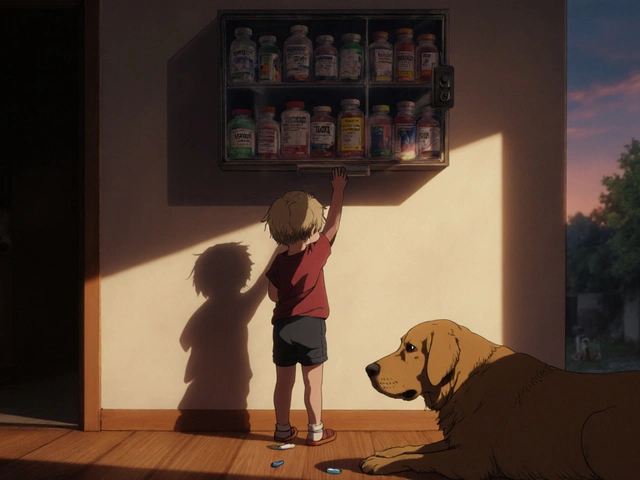
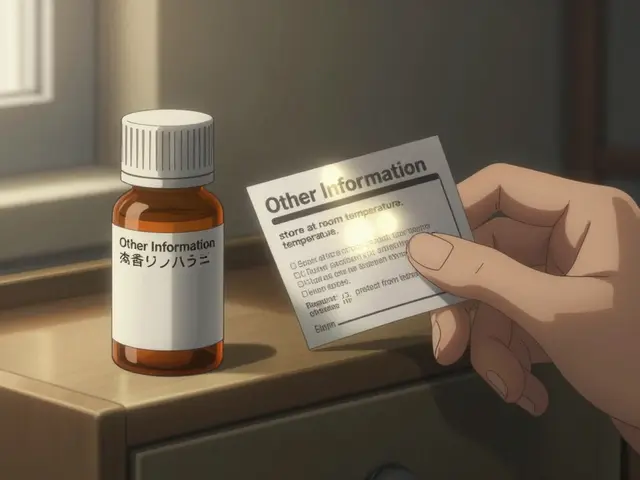

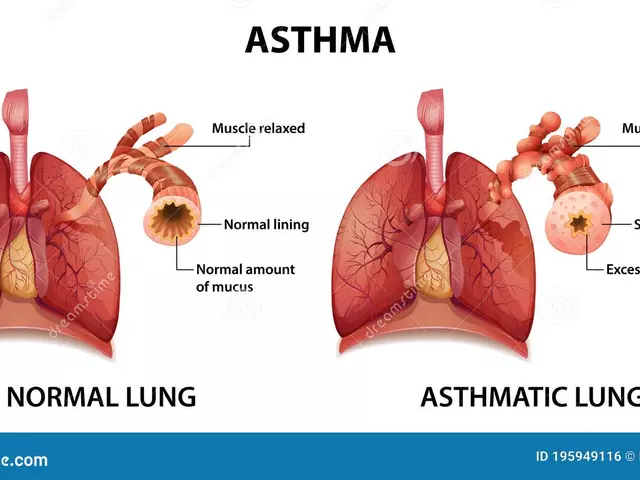
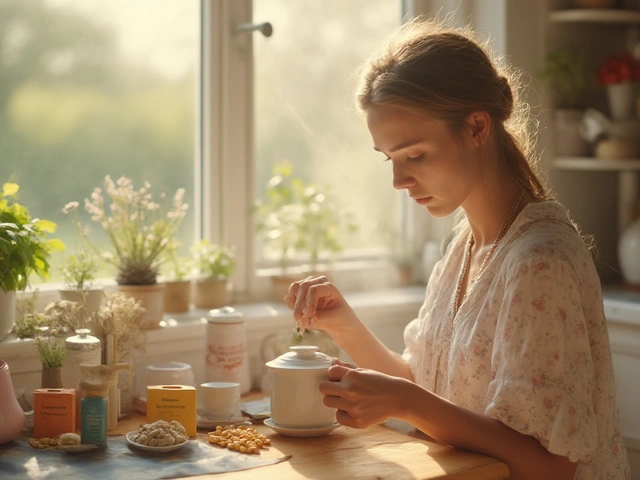
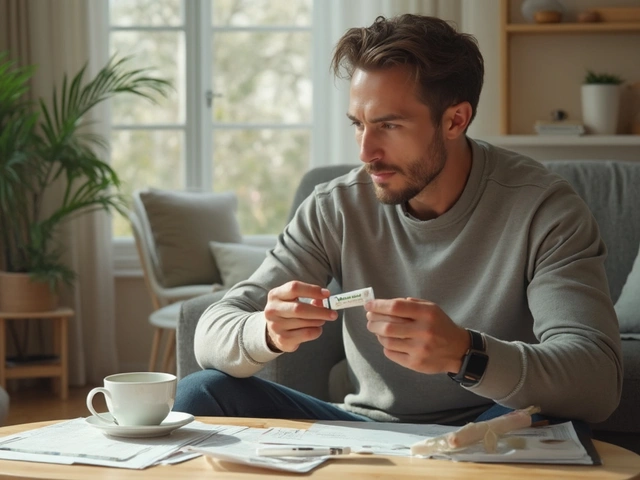


Diana Askew November 28, 2025
I told my sister this last week and she laughed. Said I'm 'paranoid'. Then her 3-year-old got into the Advil bottle. Now she's crying in the ER. 😔 Kids don't care if it's 'child-resistant'. They care if it's shiny and tastes like grape. Lock it. High. Separate. Or prepare for trauma.
King Property November 29, 2025
You think this is new? My grandma stored meds in a locked toolbox since the 70s. Back then, people didn't need blog posts to know not to leave pills on the counter. Now we need a 2000-word essay because everyone's too lazy to put shit away. Child-resistant caps? Pfft. They're for people who think 'effort' is a four-letter word.
Yash Hemrajani November 30, 2025
Ah yes, the classic 'store meds like contraband' advice. I'm glad someone finally said it. But let's be real - most people won't buy a $20 lockbox. So here's a free hack: use an empty coffee tin. Paint it. Label it 'Blessings Only'. Put it on the top shelf. Kids think it's a treasure chest. Pets think it's a mystery. Win-win. 😏
Pawittar Singh November 30, 2025
Look, I get it. You're tired. You're busy. You gave your kid their medicine and your dog licked the floor. But this isn't about being perfect - it's about being present. One habit. One lockbox. One moment where you say 'I'm not risking my baby's life because I was too tired to put the bottle away.' You got this. And if you need help finding a cheap lockbox, DM me. I'll send you the link. ❤️
Josh Evans December 1, 2025
I just did this last weekend. Bought a $12 lockbox from Target. Put all my meds in it. Put it on the top shelf in the hallway closet. My cat hasn't touched the vet bag since. My niece stopped asking why the 'candy jar' is locked. It's not hard. Just don't be lazy.
Allison Reed December 1, 2025
This is the kind of post that makes me believe in people again. Thank you for writing this with such clarity and care. The two-minute rule? Genius. The separation of human and pet meds? Lifesaving. And the disposal tip with coffee grounds? I'm doing that tomorrow. You didn't just give advice - you gave peace of mind.
Jacob Keil December 2, 2025
The real issue is capitalism. Pharma companies make gummy vitamins to hook kids. They know it's dangerous. They profit from ER visits. They don't care. Locking up meds is just band-aid on a bullet wound. We need regulation. We need bans. We need to burn the gummy vitamin industry to the ground. 🤬
Rosy Wilkens December 3, 2025
I'm not saying this is wrong, but have you considered that this is part of a larger social engineering campaign? The government wants us to store meds in lockboxes so they can track our consumption patterns. The 'VADIC Safe Storage Bag' - is that even a real company? Or a front for the CDC? I checked their website. No contact info. No address. Red flag.
Andrea Jones December 5, 2025
Okay, but let’s be honest - how many of us actually do this? I mean, I *know* I should lock my meds. But I leave my gummy vitamins on the nightstand because I’m 'just going to take them before bed'. And then I forget. And then my dog eats them. And then I’m Googling 'can dogs die from vitamin D gummies' at 2 a.m. 😅 So... what’s your secret? How do you make it stick?
Justina Maynard December 6, 2025
I once found a bottle of my neighbor’s blood pressure pills in my trash. Not just one. An entire bottle. They'd thrown it in the compost bin. I called the cops. I called poison control. I called the HOA. I called the media. I made a TikTok. Now they have a locked cabinet. And I have a new hobby: Medication Vigilantism. 🕵️♀️💊
Evelyn Salazar Garcia December 7, 2025
America is weak. We need to stop coddling kids and pets. Let them learn. One mistake. One dose. One lesson. No lockbox needed.
Clay Johnson December 8, 2025
The two-minute rule is just a distraction. The real solution is to stop taking meds altogether. The body heals itself. Modern medicine is a scam. Lock your pills if you want. But don't pretend you're saving lives when you're just feeding the pharmaceutical machine.